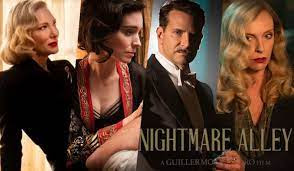I should have known better than to smuggle a chicken burrito into the theater from the taqueria next door to it. Why, you ask? Let’s just say I bit into it at an unappetizing moment in the film. If you saw the original “Nightmare Alley” (1947) with Tyrone Power, or if you know what a carnival geek is, you’ll get the idea. Bummer.
But the good news is that “Nightmare Alley” (2021), the stunningly dark reincarnation of the original, is a black-hearted wonder. Although it’s usually a bad idea to remake a great old film, and the original was just that, director Guillermo del Toro gives it a new and, yes, darker life, closer to the novel on which it is based.
The film opens before the start of World War II — at one point a character remarks that the guy who looks like Charlie Chaplin just invaded Poland. The Depression is at full dudgeon and desperation hangs over the populace like a thick toxic cloud.
In this dystopic world we encounter the amoral, tormented Stanton Carlisle (Bradley Cooper), whose life is a puzzle from the start. When we meet him, he’s committing a startlingly grim act, and only later do we learn the story behind it. He hightails it out of town and stumbles into a traveling carnival, where he’s offered temporary work, and so he mingles with the denizens of this underground culture in which it doesn’t matter who you are or what you’ve done — lucky for Stan.
He wanders into the residence of fortune teller Zeena the Seer (Toni Collette), who, with Stan, cheats on her mate Pete (David Strathairn), but seems a kind-hearted soul compared with the vipers who populate the traveling carney.
Detestable carney boss Clem Hoatley (Willem Dafoe) oversees a particularly grotesque carnival attraction, an assortment of glass jars that contain a virtual museum of deformities with remains floating in liquid preservatives. One, in particular, an infant with a protrusion through the forehead, whose mother died in childbirth, reappears on the screen from time to time, darkly implying painful details of Stan’s history. That this is a showpiece for the ogling masses casts a dark view indeed of the populace in the years leading up to the war.
With the worst of the Depression upon them, sideshow freaks are in great demand with a public who wants someone to look down on and feel superior to, Stan is told. We soon meet the most degraded sideshow performer, the geek, a tragically demented man who bites the heads off chickens for the audience’s savage amusement and is kept in a cage like an animal.
When the geek escapes from captivity, Stan is ordered to help flush him out of the fun house where he’s likely holed up. The place is filled with monsters and other spooky things rendered in wood, cardboard and plaster of paris, a delightfully hellish landscape filled with playful menace. It may also serve as an ominous glimpse into Stan’s future.
More ominous still, Zeena’s tarot cards predict Stan will face the opportunity to choose between a straight and narrow life and doom. When this comes to pass, we already know which path he’ll choose.
Stan meets Molly Cahill (Rooney Mara), the carney’s electrically charged sideshow performer — she is able to withstand large surges of electrical current that flash across her body like a lightning storm. She’s a sweet girl who manages to stay removed from the sideshow ruffians thanks to the watchful eye of carney strongman Bruno (Ron Perlman), who keeps her out of harm’s way. Unfortunately for her, she comes to believe in Stan, much to Bruno’s dismay, and the two become an item.
Stan has ambitions to go on the road with the mentalist act he swipes from Zeena’s Pete, a good-hearted but weary tippler. Stan wants to go after well-heeled dupes who are ripe for the picking. The other carneys urge Stan to avoid doing a “spook show” — posing as a true mind-reader and spiritualist, which is a line that none of them will cross. But, Stan’s all too ready to hoodwink suckers with fatter wallets than the beaten-down masses who crowd the sideshows, so he and Molly leave the carney behind and eventually make the leap to the upscale nightclub circuit.
It’s not long before he connects with a slippery psychologist, Dr. Lilith Ritter (Cate Blanchett), a seductive shape-shifter who, to paraphrase Raymond Chandler, is a blonde to make a bishop kick a hole in a stained-glass window. They begin an affair of sorts, and she offers him the means to cash in on some wealthy dupes. He lands a promising but somewhat dangerous client, troubled millionaire Ezra Grindle (Richard Jenkins).
But, with every silver lining comes a dark cloud, and Stan is eventually in for a precipitous fall — this is noir, after all, and that's a prime convention of the genre.
Speaking of conventions, most traditional noirs were shot cheaply, which meant that color film was verboten. Del Toro wants to release a black and white version of his film. The muted tones of the color print are quietly effective, but it would be thrilling to see it in black in white. Let’s hope that happens.
As remakes go, “Nightmare Alley” more than holds its own with its many outstanding performances, even in the smaller roles, wonderful direction and taut script. What sets it apart from standard Hollywood do-overs is its refusal to compromise. True to its noir roots, the film is an oddity today, minus an upbeat ending calculated to resonate with the masses, and that’s a good thing. The chilling conclusion is devastating. Be warned, if you’re hoping for even a glimmer of sunshine when emerging from this darkened house of horrors you may need whiskey — but hold the chicken burrito.

